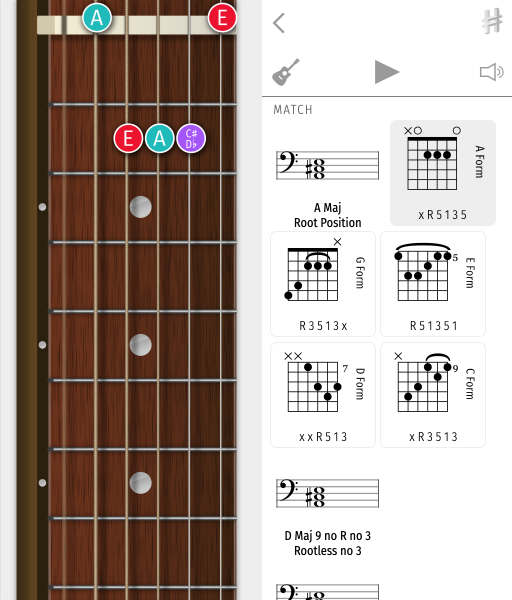CAGED Fretboard System
Theory
Standard tuning on a six-string guitar offers certain familiar open chord shapes for major triads: C, A, G, E, D (CAGED). This reminds us how a single chord can be played by moving through successive shapes, played as barre chords, across the fretboard.
CAGED Fretboard System
The CAGED system, made popular by Bill Edwards (see References), helps visualize certain patterns up and down the fretboard. This is easily seen in the interactive fret search widget, which allows you to the enter notes of a chord and see other ways to play the chord.

For example for A Major voicings in Root Position, the forms occur in the order A Form, G Form, E Form, D Form, C Form, and back to A Form at the octave (twelfth fret). (The form names are written sideways on the right of a fret diagram.)
Harmonious applies the CAGED nomenclature to other types of chords (minor triads, etc.).
Extended Forms


A few example F Form chords.
Left: F Maj 7. Right: E Aug Triad.
Harmonious also adds other form names, such as F form and B form, to allow two different collections of Chord Forms based on on where the root is, and on which string.
Root on Low E String
- G Form: all notes down the fretboard from the root (closer to the nut)
- E Form: all notes up the fretboard from the root, root often played with barre finger
Root on A String
- C Form: all notes down the fretboard from the root (closer to the nut)
- A Form: all notes up the fretboard from the root, root often played with barre finger
Root on D String
- F Form: all notes down the fretboard from the root (closer to the nut)
- D Form: all notes up the fretboard from the root, root often played with barre finger
The use of CAGED forms in Harmonious is mostly just a mnemonic to help remember how to play different chord voicings and how to think about how these forms relate to one another. CAGED is not a water-tight system for understanding all music theory exhaustively (scales for example), but it is useful to have a shorthand for describing a variety of chord shapes.
Standard tuning on a six-string guitar offers certain familiar open chord shapes for major triads: C, A, G, E, D (CAGED). This reminds us how a single chord can be played by moving through successive shapes, played as barre chords, across the fretboard.
CAGED Fretboard System
The CAGED system, made popular by Bill Edwards (see References), helps visualize certain patterns up and down the fretboard. This is easily seen in the interactive fret search widget, which allows you to the enter notes of a chord and see other ways to play the chord.

For example for A Major voicings in Root Position, the forms occur in the order A Form, G Form, E Form, D Form, C Form, and back to A Form at the octave (twelfth fret). (The form names are written sideways on the right of a fret diagram.)
Harmonious applies the CAGED nomenclature to other types of chords (minor triads, etc.).
Extended Forms
A few example F Form chords.
Left: F Maj 7. Right: E Aug Triad.
Harmonious also adds other form names, such as F form and B form, to allow two different collections of Chord Forms based on on where the root is, and on which string.
Root on Low E String
- G Form: all notes down the fretboard from the root (closer to the nut)
- E Form: all notes up the fretboard from the root, root often played with barre finger
Root on A String
- C Form: all notes down the fretboard from the root (closer to the nut)
- A Form: all notes up the fretboard from the root, root often played with barre finger
Root on D String
- F Form: all notes down the fretboard from the root (closer to the nut)
- D Form: all notes up the fretboard from the root, root often played with barre finger
The use of CAGED forms in Harmonious is mostly just a mnemonic to help remember how to play different chord voicings and how to think about how these forms relate to one another. CAGED is not a water-tight system for understanding all music theory exhaustively (scales for example), but it is useful to have a shorthand for describing a variety of chord shapes.